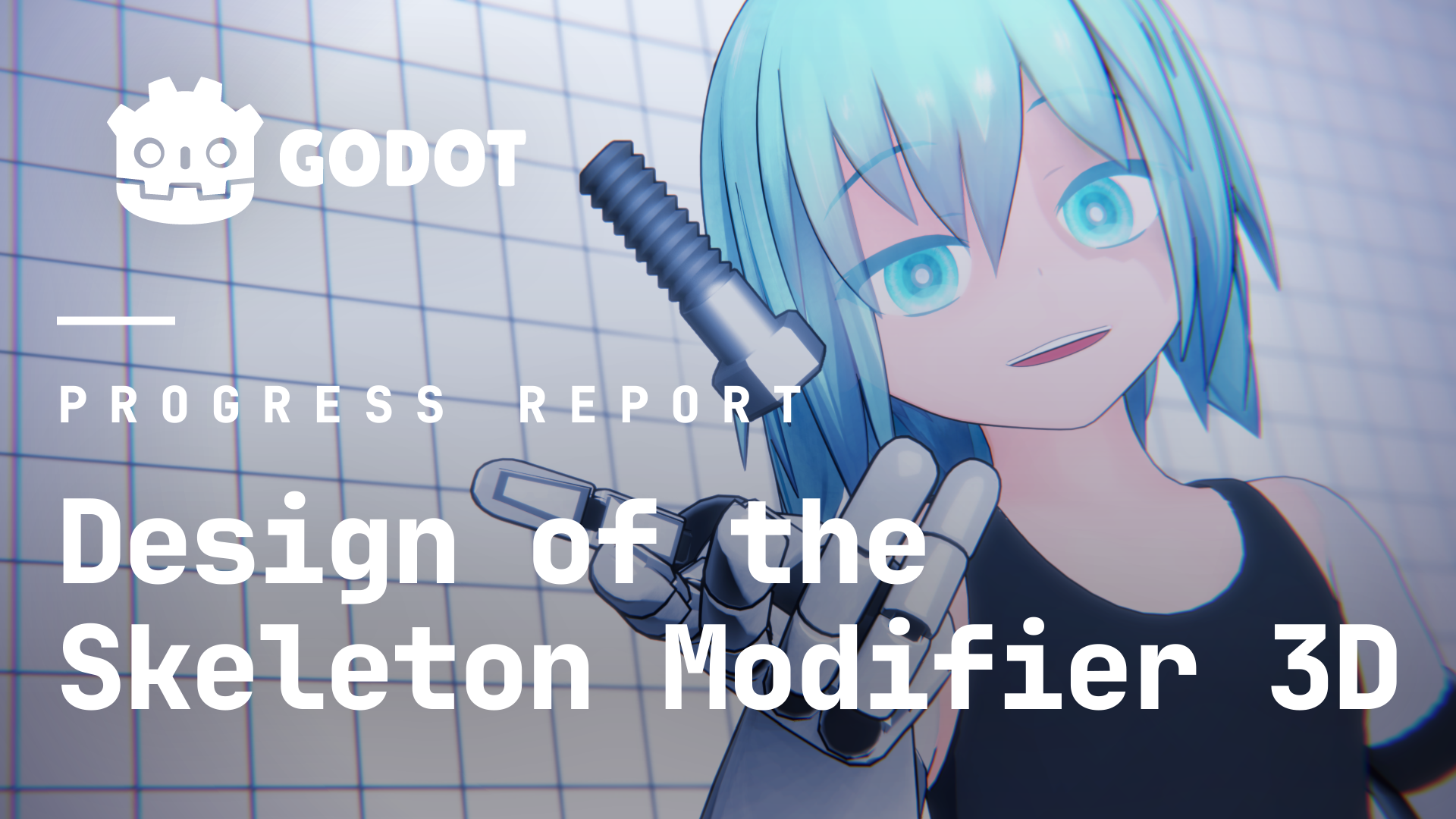In Godot 4.3 we are adding a new node called SkeletonModifier3D. It is used to animate Skeleton3Ds outside of AnimationMixer and is now the base class for several existing nodes.
As part of this we have deprecated (but not removed) some of the pose override functionality in Skeleton3D including:
set_bone_global_pose_override()get_bone_global_pose_override()get_bone_global_pose_no_override()clear_bones_global_pose_override()
Did the pose override design have problems?
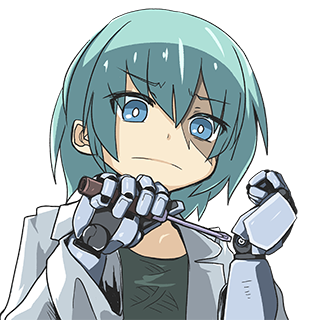
Previously, we recommended using the property global_pose_override when modifying the bones. This was useful because the original pose was kept separately, so blend values could be set, and bones could be modified without changing the property in .tscn file. However, the more complex people’s demands for Godot 3D became, the less it covered the use cases and became outdated.
The main problem is the fact that “the processing order between Skeleton3D and AnimationMixer is changed depending on the SceneTree structure`.
For example, it means that the following two scenes will have different results:
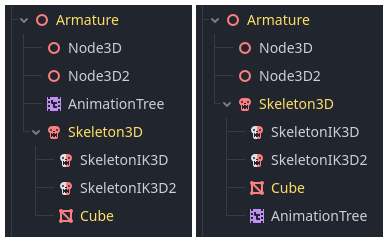
If there is a modifier such as IK or physical bone, in most cases, it needs to be applied to the result of the played animation. So they need to be processed after the AnimationMixer.
In the old skeleton modifier design with bone pose override you must place those modifiers below the AnimationMixer. However as scene trees become more complex, it becomes difficult to keep track of the processing order. Also the scene might be imported from glTF which cannot be edited without localization, so managing node order becomes tedious.
Moreover, if multiple nodes use bone pose override, it breaks the modified result.
Let’s imagine a case in which bone modification is performed in the following order:
AnimationMixer -> ModifierA -> ModifierB
Keep in mind that both ModifierA and ModifierB need to get the bone pose that was processed immediately before.
The AnimationMixer does not use set_bone_global_pose_override(), so it transforms the original pose as set_bone_pose_rotation(). This means that the input to ModifierA must be retrieved from the original pose with get_bone_global_pose_no_override() and the output must be retreived from the override with get_bone_global_pose_override(). In this case, if ModiferB wants to consider the output of ModiferA, both the input and output of ModifierB must be the override with get_bone_global_pose_override().
Then, can the order of ModifierA and ModifierB be interchanged?
–The answer is “NO”.
Because ModifierB’s input is now get_bone_global_pose_override() which is different from get_bone_global_pose_no_override(), so ModifierB cannot get the original pose set by the AnimationMixer.
As I described above, the override design was very weak in terms of process ordering.
How does the new skeleton design work with SkeletonModifier3D?
SkeletonModifier3D is designed to modify bones in the _process_modification() virtual method. This means that if you want to develop a custom SkeletonModifier3D, you will need to modify the bones within that method.
SkeletonModifier3D does not execute modifications by itself, but is executed by the parent of Skeleton3D. By placing SkeletonModifier3D as a child of Skeleton3D, they are registered in Skeleton3D, and the process is executed only once per frame in the Skeleton3D update process. Then, the processing order between modifiers is guaranteed to be the same as the order of the children in Skeleton3D’s child list.
Since AnimationMixer is applied before the Skeleton3D update process, SkeletonModifier3D is guaranteed to run after AnimationMixer. Also, they do not require bone_pose_global_override; This removes any confusion as to whether we should use override or not.
Here is a SkeletonModifier3D sequence diagram:
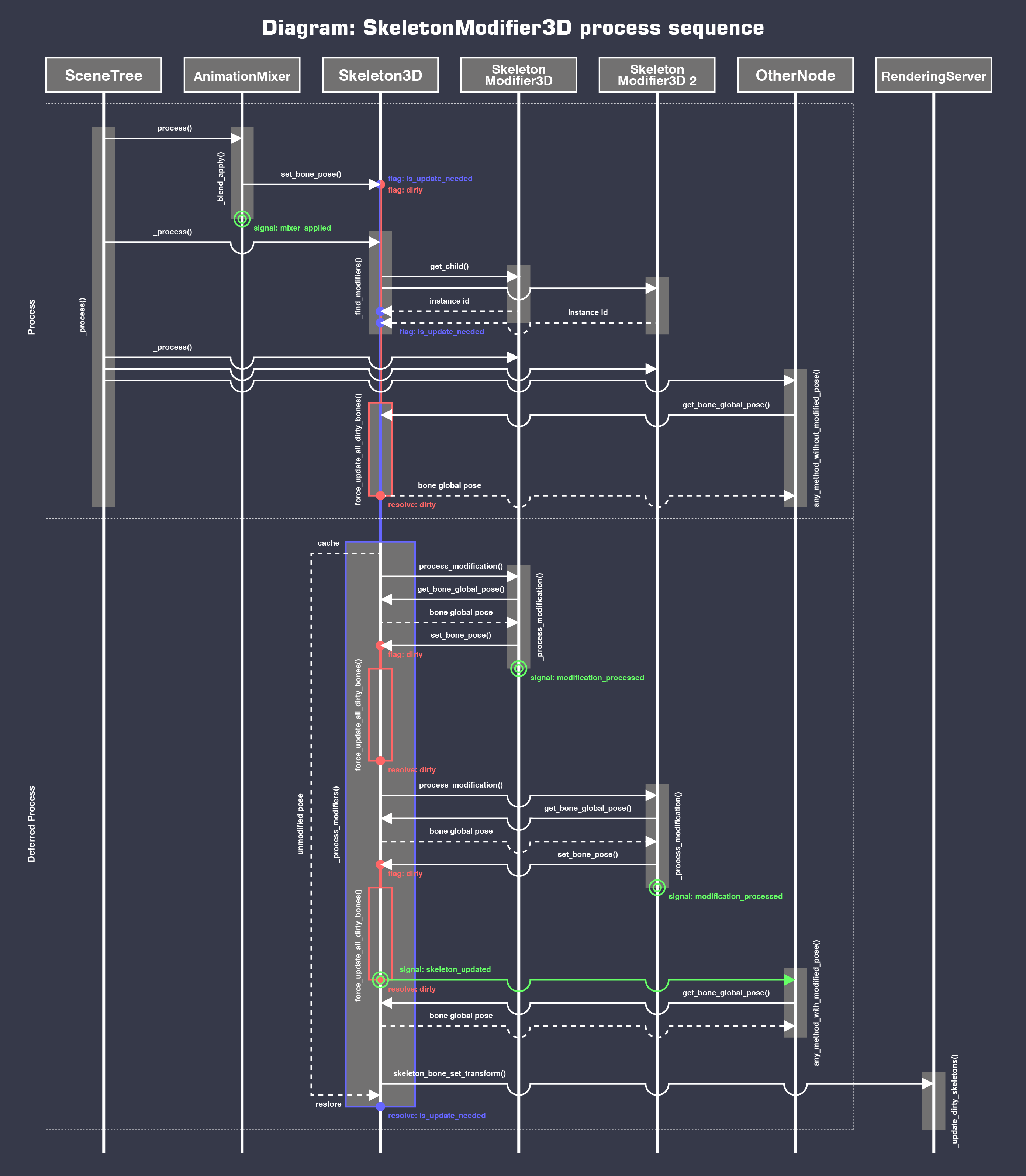
Dirty flag resolution may be performed several times per frame, but the update process is a deferred call and is performed only once per frame.
At the beginning of the update process, it stores the pose before the modification process temporarily. When the modification process is complete and applied to the skin, the pose is rolled back to the temporarily stored pose. This performs the role of the past bone_pose_global_override which stored the override pose separate from the original pose.
By the way, you may want to get the pose after the modification, or you may wonder why the modifier in the later part cannot enter the original pose when there are multiple modifiers.
We have added some signals for cases where you need to retrieve the pose at each point in time, so you can use them.
- AnimationMixer: mixer_applied
- Notifies when the blending result related have been applied to the target objects
- SkeletonModifier3D: modification_processed
- Notifies when the modification have been finished
- Skeleton3D: skeleton_updated
- Emitted when the final pose has been calculated will be applied to the skin in the update process
Also, note that this process depends on the Skeleton3D.modifier_callback_mode_process property.

For example, in a use case that the node uses the physics process outside of Skeleton3D and it affects SkeletonModifier3D, the property must be set to Physics.
Finally, now we can say that SkeletonModifier3D does not make it impossible to do anything that was possible in the past.
How to make a custom SkeletonModifier3D?
SkeletonModifier3D is a virtual class, so you can’t add it as stand alone node to a scene.
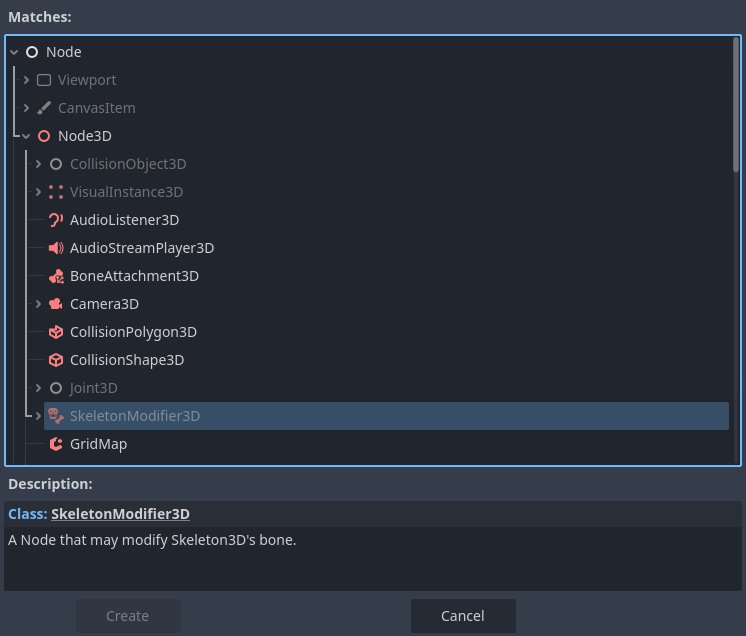
Then, how do we create a custom SkeletonModifier3D? Let’s try to create a simple custom SkeletonModifier3D that points the Y-axis of a bone to a specific coordinate.
1. Create a script
Create a blank gdscript file that extends SkeletonModifier3D. At this time, register the custom SkeletonModifier3D you created with the class_name declaration so that it can be added to the scene dock.
class_name CustomModifier
extends SkeletonModifier3D

2. Add some declarations and properties
If necessary, add a property to set the bone by declaring @export_enum and set the Skeleton3D bone names as a hint in _validate_property(). You also need to declare @tool if you want to select it in the editor.
@tool
class_name CustomModifier
extends SkeletonModifier3D
@export var target_coordinate: Vector3 = Vector3(0, 0, 0)
@export_enum(" ") var bone: String
func _validate_property(property: Dictionary) -> void:
if property.name == "bone":
var skeleton: Skeleton3D = get_skeleton()
if skeleton:
property.hint = PROPERTY_HINT_ENUM
property.hint_string = skeleton.get_concatenated_bone_names()
The @tool declaration is also required for previewing modifications by SkeletonModifier3D, so you can consider it is required basically.
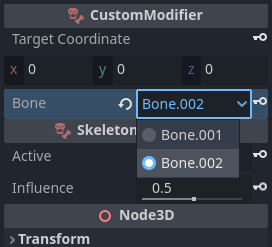
3. Coding calculations of the modification in _process_modification()
@tool
class_name CustomModifier
extends SkeletonModifier3D
@export var target_coordinate: Vector3 = Vector3(0, 0, 0)
@export_enum(" ") var bone: String
func _validate_property(property: Dictionary) -> void:
if property.name == "bone":
var skeleton: Skeleton3D = get_skeleton()
if skeleton:
property.hint = PROPERTY_HINT_ENUM
property.hint_string = skeleton.get_concatenated_bone_names()
func _process_modification() -> void:
var skeleton: Skeleton3D = get_skeleton()
if !skeleton:
return # Never happen, but for the safety.
var bone_idx: int = skeleton.find_bone(bone)
var parent_idx: int = skeleton.get_bone_parent(bone_idx)
var pose: Transform3D = skeleton.global_transform * skeleton.get_bone_global_pose(bone_idx)
var looked_at: Transform3D = _y_look_at(pose, target_coordinate)
skeleton.set_bone_global_pose(bone_idx, Transform3D(looked_at.basis.orthonormalized(), skeleton.get_bone_global_pose(bone_idx).origin))
func _y_look_at(from: Transform3D, target: Vector3) -> Transform3D:
var t_v: Vector3 = target - from.origin
var v_y: Vector3 = t_v.normalized()
var v_z: Vector3 = from.basis.x.cross(v_y)
v_z = v_z.normalized()
var v_x: Vector3 = v_y.cross(v_z)
from.basis = Basis(v_x, v_y, v_z)
return from
_process_modification() is a virtual method called in the update process after the AnimationMixer has been applied, as described in the sequence diagram above. If you modify bones in it, it is guaranteed that the order in which the modifications are applied will match the order of SkeletonModifier3D of the Skeleton3D’s child list.
Note that the modification should always be applied to the bones at 100% amount. Because SkeletonModifier3D has an influence property, the value of which is processed and interpolated by Skeleton3D. In other words, you do not need to write code to change the amount of modification applied; You should avoid implementing duplicate interpolation processes. However, if your custom SkeletonModifier3D can specify multiple bones and you want to manage the amount separately for each bone, it makes sense that adding the amount properties for each bone to your custom modifier.
Finally, remember that this method will not be called if the parent is not a Skeleton3D.
4. Retrieve modified values from other Nodes
The modification by SkeletonModifier3D is immediately discarded after it is applied to the skin, so it is not reflected in the bone pose of Skeleton3D during _process().
If you need to retrieve the modificated pose values from other nodes, you must connect them to the appropriate signals.
For example, this is a Label3D which reflects the modification after the animation is applied and after all modifications are processed.
@tool
extends Label3D
@onready var poses: Dictionary = { "animated_pose": "", "modified_pose": "" }
func _update_text() -> void:
text = "animated_pose:" + str(poses["animated_pose"]) + "\n" + "modified_pose:" + str(poses["modified_pose"])
func _on_animation_player_mixer_applied() -> void:
poses["animated_pose"] = $"../Armature/Skeleton3D".get_bone_pose(1)
_update_text()
func _on_skeleton_3d_skeleton_updated() -> void:
poses["modified_pose"] = $"../Armature/Skeleton3D".get_bone_pose(1)
_update_text()
You can see the pose is different depending on the signal.

Download
skeleton-modifier-3d-demo-project.zip
Do I always need to create a custom SkeletonModifier3D when modifying a Skeleton3D bone?
As explained above, the modification provided by SkeletonModifier3D is temporary. So SkeletonModifier3D would be appropriate for effectors and controllers as post FX.
If you want permanent modifications, i.e., if you want to develop something like a bone editor, then it makes sense that it is not a SkeletonModifier3D. Also, in simple cases where it is guaranteed that no other SkeletonModifier3D will be used in the scene, your judgment will prevail.
What kind of SkeletonModifier3D nodes are included in Godot 4.3?
For now, Godot 4.3 will be containing only SkeletonModifier3D which is a migration of several existing nodes that have been in existence since 4.0.
But, there is good news! We are planning to add some built in SkeletonModifier3Ds in Godot 4.4, such as new IK, constraint, and springbone/jiggle.
If you are interested in developing your own effect using SkeletonModifier3D, feel free to make a proposal to include it in core.
Support
Godot is a non-profit, open source game engine developed by hundreds of contributors on their free time, as well as a handful of part or full-time developers hired thanks to generous donations from the Godot community. A big thank you to everyone who has contributed their time or their financial support to the project!
If you’d like to support the project financially and help us secure our future hires, you can do so using the Godot Development Fund platform managed by Godot Foundation. There are also several alternative ways to donate which you may find more suitable.
